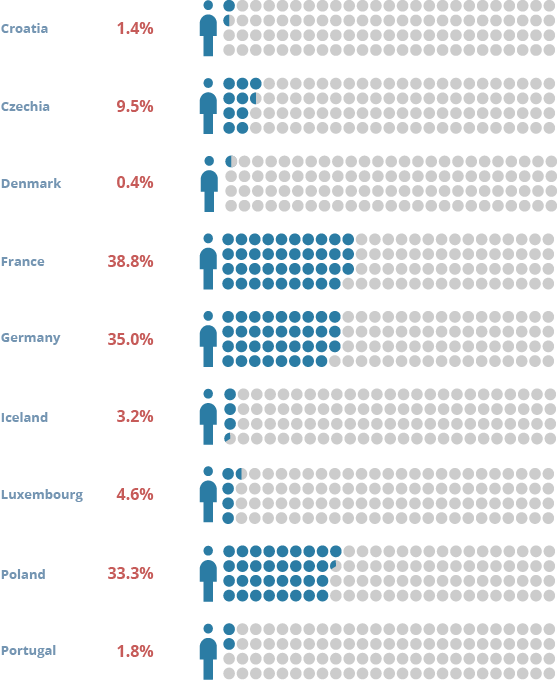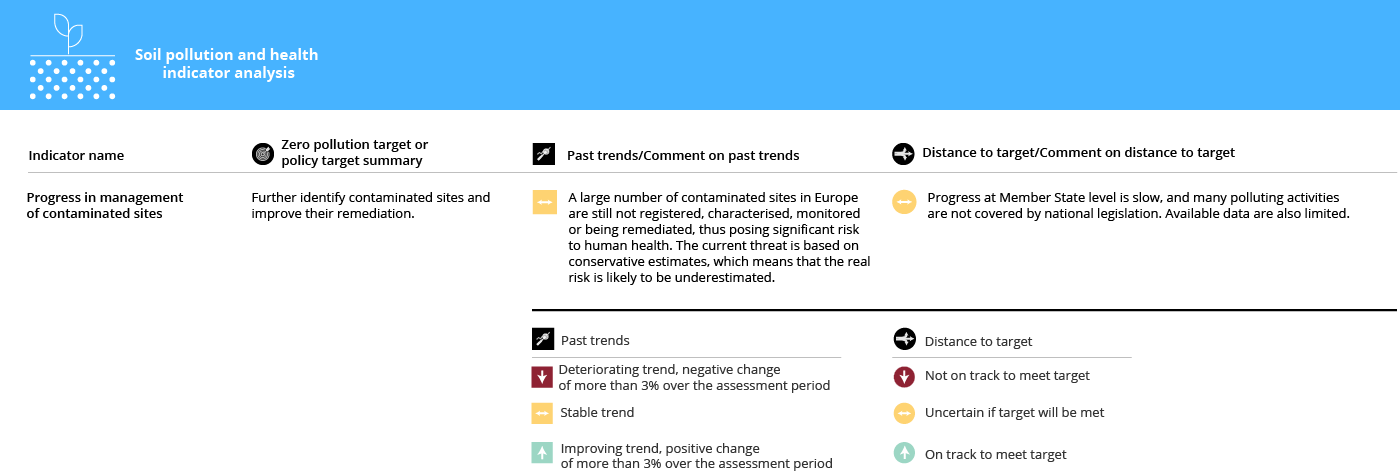De Vries, W., et al., 2022, Impacts of nutrients and heavy metals in European agriculture — current and critical inputs in relation to air, soil and water quality, ETC-DI Report 2022/01, European Topic Centre on Data Integration and Digitalisation (https://www.eionet.europa.eu/etcs/etc-di/products/impacts-of-nutrients-and-heavy-metals-in-european-agriculture-current-and-critical-inputs-in-relation-to-air-soil-and-water-quality) accessed 6 October 2022.
EC, 2021, Communication from the Commission to the European Parliament, the Council, the European Economic and Social Committee and the Committee of the Regions ‘EU soil strategy for 2030 — reaping the benefits of healthy soils for people, food, nature and climate’ (COM(2021) 699 final of 17 November 2021) (https://eur-lex.europa.eu/legal-content/EN/TXT/PDF/?uri=CELEX:52021DC0699&from=EN) accessed 9 October 2022.
EEA, 2022, ‘Progress in management of contaminated sites in Europe’, European Environment Agency (https://www.eea.europa.eu/ims/progress-in-the-management-of) accessed 5 December 2022.
Ernst and Young, 2013, Evaluation of expenditure and jobs for addressing soil contamination in Member States, ENV.B.1/ETU/2011/0012, European Commission Directorate-General Environment, Brussels (https://ec.europa.eu/environment/archives/funding/pdf/calls2011/specifications_en_11012.pdf) accessed 6 October 2022.
HBM4EU, 2022a, Cadmium, HBM4EU Policy Brief, European Human Biomonitoring Initiative (https://www.hbm4eu.eu/wp-content/uploads/2022/07/HBM4EU_Policy-Brief-Cadmium.pdf) accessed 9 October 2022.
HBM4EU, 2022b, Policy implications of the indicators,Additional Deliverable Report AD5.6, WP5 — translation of results into policy, European Human Biomonitoring Initiative (https://www.hbm4eu.eu/work-packages/additional-deliverable-5-6-policy-implications-of-the-indicators/) accessed 6 October 2022.
JRC, 2022, Zero pollution outlook 2022, JRC129655, Publications Office of the European Union, Luxembourg, Joint Research Centre (https://joint-research-centre.ec.europa.eu/zero-pollution-outlook-2022_en) accessed 1 December 2022.
Landrigan, P. J., et al., 2018, ‘The Lancet Commission on pollution and health’, The Lancet 391, pp. 462-512 (https://doi.org/10.1016/S0140-6736(17)32345-0).
Levasseur, P., et al., 2021, ‘The health and socioeconomic costs of exposure to soil pollution: evidence from three polluted mining and industrial sites in Europe’, Journal of Public Health 30, pp. 2533-2546, (https://doi.org/10.1007/s10389-021-01533-x).
Li, G., et al., 2018, ‘Urban soil and human health: a review’, European Journal of Soil Science 69, pp. 196-215 (https://doi.org/10.1111/ejss.12518).
Maddela, N. R., et al., 2022, ‘Major contaminants of emerging concern in soils: a perspective on potential health risks’, RSC Advances 12, pp. 12396-12415 (https://doi.org/10.1039/D1RA09072K).
Montanarella, L. and Panagos, P., 2021, ‘The relevance of sustainable soil management within the European Green Deal’, Land Use Policy 100, 104950 (https://doi.org/10.1016/j.landusepol.2020.104950).
Morrens, B., et al., 2012, ‘Environmental justice under our skin? Socio-stratifying human biomonitoring results of adolescents living near an industrial hotspot in Flanders, Belgium’, in: Looking within: finding an environmental justice and global citizenship lens, Brill Publishing, Netherlands (https://doi.org/10.1163/9781848882515_017).
Montanarella, L. and Panagos, P., 2021, ‘The relevance of sustainable soil management within the European Green Deal’, Land Use Policy100, 104950 (https://doi.org/10.1016/j.landusepol.2020.104950).
Ougier, E., et al., 2021, ‘Burden of osteoporosis and costs associated with human biomonitored cadmium exposure in three European countries: France, Spain and Belgium’, International Journal of Hygiene and Environmental Health 234, 113747 (https://doi.org/10.1016/j.ijheh.2021.113747).
Payá Pérez, A. and Rodríguez Eugenio, N., 2018, Status of local soil contamination in Europe: revision of the indicator ‘Progress in the management contaminated sites in Europe’, JRC Technical Report JRC107508, Publications Office of the European Union, Luxembourg (http://dx.doi.org/10.2760/093804).
Rinklebe, J., et al., 2019, ‘Health risk assessment of potentially toxic elements in soils along the Central Elbe River, Germany’, Environment International 126, pp. 76-88 (https://doi.org/10.1016/j.envint.2019.02.011).
Rodríguez-Eugenio, N., et al., 2018, Soil pollution: a hidden reality, Food and Agriculture Organization of the United Nations, Rome (https://www.fao.org/3/I9183EN/i9183en.pdf) accessed 6 October 2022.
Shaddick, G., et al., 2018, ‘Towards an assessment of the health impact of industrially contaminated sites: waste landfills in Europe’, Epidemiologia & Prevenzione 42(5-6; Suppl. 1): pp. 69-75 (https://doi.org/10.19191/ep18.5-6.s1.p069.089).
Snoj Tratnik, J. et al., 2022, ‘Cadmium exposure in adults across Europe: Results from the HBM4EU Aligned Studies survey 2014–2020’, International Journal of Hygiene and Environmental Health, 246, 114050, (https://doi.org/10.1016/j.ijheh.2022.114050).
Wilhelm, M., et al., 2005, ‘Human biomonitoring of cadmium and lead exposure of child-mother pairs from Germany living in the vicinity of industrial sources (Hot Spot Study NRW)’, Journal of Trace Elements in Medicine and Biology19, pp. 83-90 (http://dx.doi.org/10.1016/j.jtemb.2005.07.003).




Document Actions
Share with others